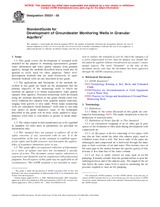Potřebujeme váš souhlas k využití jednotlivých dat, aby se vám mimo jiné mohly ukazovat informace týkající se vašich zájmů. Souhlas udělíte kliknutím na tlačítko „OK“.
ASTM D5521-05
Standard Guide for Development of Groundwater Monitoring Wells in Granular Aquifers
Automaticky přeložený název:
Standardní Příručka pro rozvoj monitorování podzemních vod Wells v granulovaných zvodních
NORMA vydána dne 1.11.2005
Informace o normě:
Označení normy: ASTM D5521-05
Poznámka: NEPLATNÁ
Datum vydání normy: 1.11.2005
Kód zboží: NS-31541
Počet stran: 17
Přibližná hmotnost: 51 g (0.11 liber)
Země: Americká technická norma
Kategorie: Technické normy ASTM
Anotace textu normy ASTM D5521-05 :
Keywords:
aquifer, groundwater, high-velocity, hydraulic jetting, jetting, mechanical surging, monitoring well, over-pumping and backwashing, representative sample, well development: Granular aquifers, Ground water, Maintenance (of ground-water wells), Wells
Doplňující informace
| Significance and Use | ||||||
|
A properly designed, installed, and developed groundwater monitoring well, constructed in accordance with Practice D5092 should provide the following: representative samples of groundwater that can be analyzed to determine physical properties and water-quality parameters of the sample or potentiometric levels that are representative of the total hydraulic head of that portion of the aquifer screened by the well, or both. Such a well may also be utilized for conducting aquifer tests used for the purpose of determining the hydraulic properties of the geologic materials in which the well has been completed. Well development is an important component of monitoring well completion. Monitoring wells installed in aquifers should be sufficiently developed to ensure that they serve their intended objectives. Well development methods vary with the physical characteristics of the geologic formation in which the monitoring well is screened, the construction details of the well, the drilling method used during the construction of the borehole in which the well is installed, and the quality of the water. The development method for each individual monitoring well should be selected from among the several methods described in this guide and should be employed by the well construction contractor or the person responsible for monitoring well completion. The importance of well development in monitoring wells cannot be overestimated; all too often development is not performed or is carried out inadequately. Proper and careful well development will improve the ability of most monitoring wells to provide representative, unbiased chemical and hydraulic data. The additional time and money spent performing this important step in monitoring well completion will minimize the potential for damaging pumping equipment and in-situ sensors, and increase the probability that groundwater samples are representative of water contained in the monitored formation. |
||||||
| 1. Scope | ||||||
|
1.1 This guide covers the development of screened wells installed for the purpose of obtaining representative groundwater information and water quality samples from granular aquifers, though the methods described herein could also be applied to wells used for other purposes. Other well-development methods that are used exclusively in open-borehole bedrock wells are not described in this guide. 1.2 The applications and limitations of the methods described in this guide are based on the assumption that the primary objective of the monitoring wells to which the methods are applied is to obtain representative water quality samples from aquifers. Screened monitoring wells developed using the methods described in this guide should yield relatively sediment-free samples from granular aquifer materials, ranging from gravels to silty sands. While many monitoring wells are considered “small-diameter” wells (that is, less than four inches in inside diameter), some of the techniques described in this guide will be more easily applied to large-diameter wells (that is, four-inches or greater in inside diameter). 1.3 The values stated in inch-pound units are to be regarded as standard. All other units in parentheses are provided for information only. 1.4 This standard does not purport to address all of the safety concerns, if any, associated with its use. It is the responsibility of the user of this standard to establish appropriate safety and health practices and determine the applicability of regulatory limitations prior to use. 1.5 This guide offers an organized collection of information or a series of options and does not recommend a specific course of action. This document cannot replace education or experience and should be used in conjunction with professional judgment. Not all aspects of this guide may be applicable in all circumstances. This ASTM standard is not intended to represent or replace the standard of care by which the adequacy of a given professional service must be judged, nor should this document be applied without consideration of a project's many unique aspects. The word “Standard” in the title of this document means only that the document has been approved through the ASTM consensus process. |
||||||
| 2. Referenced Documents | ||||||
|
Odebírejte informace o nově vydaných normách ZDARMA:
Chcete pravidelně odebírat informace o nově vycházejících normách z celého světa a to zcela zdarma?
Přihlašte se k odběru. Vše je velice jednoduché a absolutně ZDARMA.
Na výběr máte vydavatele z celého světa.




 Cookies
Cookies
